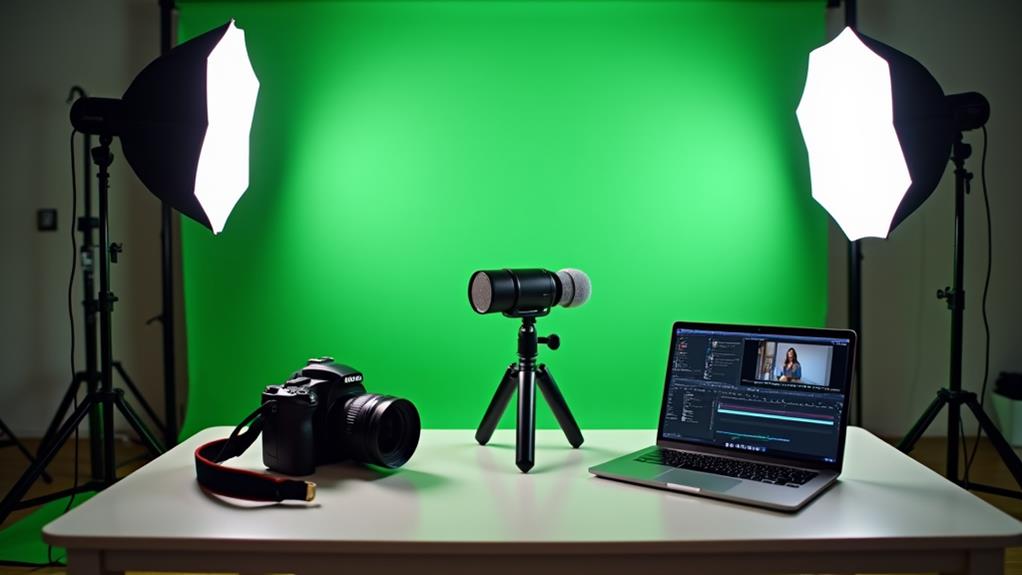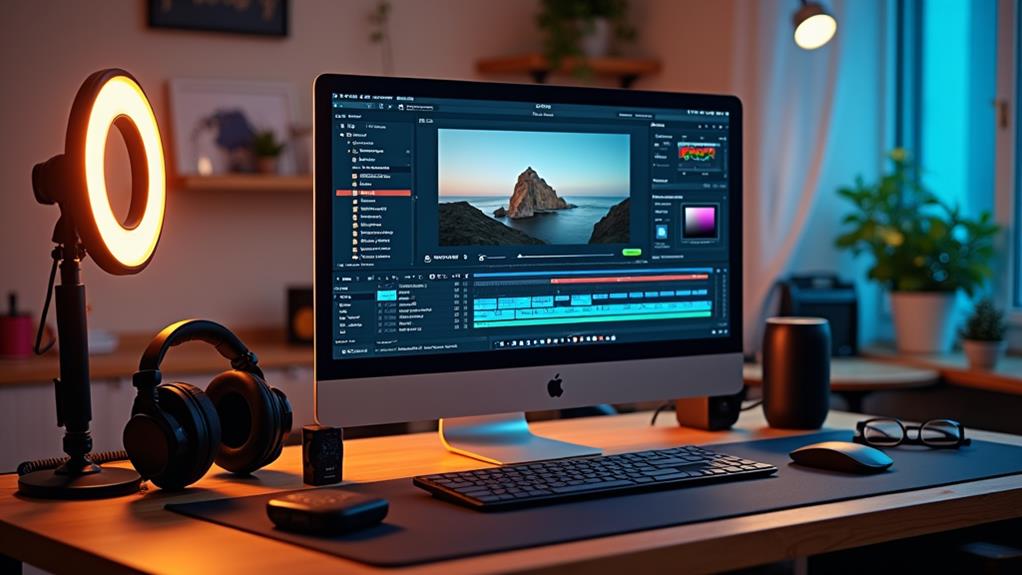
Creating high-quality online course videos on a budget requires strategic planning and cost-effective equipment. Utilize high-resolution smartphones paired with budget-friendly tripods for stable footage. Implement a simple lighting setup with ring lights or natural light for balanced illumination. Choose plain yet professional backgrounds to minimize distractions. Employ external microphones to enhance audio clarity. Effective editing can be achieved using free software like DaVinci Resolve or Shotcut. By incorporating tight shooting segments and efficient post-production techniques, even budget constraints won't hinder a polished, professional outcome. As we uncover more details, you'll discover further techniques to refine your courses.
Key Takeaways
- Use smartphones with 1080p or 4K capabilities and a $20 tripod for stable, high-quality video.
- Implement a 3-point lighting setup using affordable ring lights or natural light to enhance video clarity.
- Choose a simple, clutter-free background and test it to ensure minimal distractions and professional appearance.
- Invest in a $30 external microphone and record in small, carpeted rooms to improve audio quality.
- Edit videos using free software like DaVinci Resolve or Shotcut for professional results on a budget.
Video Production Setup
Creating high-quality online course videos on a budget requires a strategic video production setup. Central to this strategy is the utilization of smartphones, such as iPhones or high-quality Android devices, which offer impressive camera capabilities. Confirming camera stability is vital; hence, employing a tripod or specialized phone accessories is recommended to prevent shaky footage.
Before initiating the full shoot, conduct a 10-second test to verify the video quality, focusing on stability and clarity. Leveraging versatile IDEs like Visual Studio Code can also assist in streamlining the editing process post-filming.
Filming angles play an essential role in maintaining viewer engagement and confirming a professional appearance. Experiment with various angles to determine the most flattering and effective perspectives for your instructional content. Using widescreen mode is necessary to maximize visual quality and provide a cinematic feel.
Additionally, incorporating a 3-point lighting setup can greatly enhance the video's overall quality by eliminating shadows. Affordable ring lights or natural light sources from windows can be strategically positioned to achieve ideal illumination.
Conducting thorough test recordings to assess both video and audio quality is critical. Addressing issues such as echo or distortion early in the process guarantees that the final product is both visually and audibly appealing, providing a seamless learning experience for viewers.
Choosing the Right Background
Selecting an appropriate background for your online course videos is vital in maintaining viewer focus and guaranteeing a polished, professional appearance. The choice of background aesthetics plays an important role in minimizing visual distractions and enhancing the overall viewer experience. Here are some key considerations:
1. Simplicity: Opt for a simple, clutter-free background, such as a plain wall or a black sheet. This approach keeps the focus on the subject and minimizes distractions during video recordings.
Additionally, consider leveraging dynamic content creation to foster authenticity in your setup, adding subtle elements that resonate with your audience.
2. Natural Elements: Incorporate natural elements, like a bookshelf or plants, to create a visually appealing setting. These elements can enhance the overall background aesthetics without diverting attention from the content.
3. Testing and Angle: Before finalizing, test your background by recording a short clip to assess how it appears on camera. Position your camera at an angle that properly captures the chosen background, ideally at eye level, to create a more engaging and relatable view for your audience.
Avoid complicated backgrounds such as green screens, which can be difficult to edit and may detract from the video's professionalism if not executed perfectly.
Importance of Lighting
Proper lighting is a fundamental element of high-quality video production, greatly influencing the visual clarity and engagement of your content. Effective lighting techniques can considerably reduce shadows, thus enhancing the overall clarity of your footage. Incorporating key product features using icons and labels can aid in quick comprehension and further improve your video's visual appeal.
Implementing a 3-point lighting setup, which includes a key light, fill light, and backlight, is highly recommended to achieve balanced illumination and depth. This method not only creates a professional aesthetic but also guarantees that the subject is well-lit from all angles.
Utilizing affordable ring lights or leveraging natural light from windows can dramatically improve video aesthetics without incurring considerable costs. Ring lights are particularly effective in providing even, soft illumination, while natural light offers a cost-effective alternative with high-quality results. Adjusting the color temperature of your lighting sources is vital to make sure that the footage appears natural and consistent.
Before commencing final recording sessions, it is prudent to test lighting conditions with a brief 10-second clip. This practice allows for adjustments to brightness and color temperature, ensuring ideal visual quality.
Poor lighting can decrease viewer retention, as dark or unevenly lit videos can distract and disengage audiences. As a result, investing in proper lighting techniques is essential for maintaining viewer interest and producing high-quality course videos.
Enhancing Audio Quality
When producing online course videos, how can one assure that the audio quality meets professional standards without breaking the bank? Guaranteeing high-quality audio is vital, as poor sound can detract from even the most well-crafted video content. Here are some cost-effective strategies to enhance your audio:
1. Invest in Proper Audio Equipment: Utilizing an external microphone, such as a lapel mic or a USB condenser mic, can drastically improve audio fidelity. These devices capture clearer sound and minimize background noise compared to built-in device microphones.
This small investment can also lead to a 45% increase in audience engagement, as clearer audio enhances the overall user experience.
2. Implement Soundproofing Techniques: Recording in a small, carpeted room reduces echoes and sound reflections. Additionally, incorporating soft furnishings like pillows and blankets absorbs sound and diminishes unwanted reverberations.
This results in cleaner audio tracks that are more pleasant to listen to.
3. Follow Essential Recording Tips: Proper mic placement is significant; positioning the microphone close to your mouth yet out of the camera frame guarantees ideal sound capture.
Test audio levels before recording and make necessary adjustments to confirm your voice is captured at an appropriate volume, avoiding distortion or inaudibility.
For post-production, consider using audio editing software like Audacity or Descript to further refine your recordings by removing background noise and adjusting levels for a polished, professional finish.
Budget-Friendly Video Equipment
For creators looking to produce high-quality online course videos without breaking the bank, leveraging a high-quality smartphone capable of 1080p or 4K video capture is a cost-effective alternative to expensive cameras.
Pairing this setup with a basic $20 tripod guarantees stable footage, while affordable lighting solutions, such as a $30 ring light or natural window light, can greatly enhance video clarity.
In-ear monitors can also support good microphone technique and sound isolation during recording.
Additionally, the use of economical external microphones, starting at $30, guarantees professional-grade audio, making this combination an ideal budget-friendly solution for aspiring educators.
Affordable Camera Options
Even with a limited budget, creating high-quality online course videos is achievable by leveraging cost-effective camera solutions that do not compromise on performance.
For those seeking smartphone alternatives, investing in a high-end smartphone such as an iPhone or a premium Android device is a viable option, as these devices often come equipped with advanced camera technology capable of delivering impressive video quality.
For compact camera recommendations, consider models such as the Canon PowerShot series or the Sony ZV-1. These cameras offer excellent video performance and portability, making them ideal for educators on a budget.
When conducting a video performance comparison, these compact cameras often rival more expensive options, providing a balance between affordability and functionality.
To further enhance your filming setup, consider these affordable camera accessories:
- Tripods/Stabilizers: Available for under $50, these tools guarantee stable and shake-free footage.
- External Microphones: Options like lapel or shotgun mics, priced below $100, greatly improve audio clarity.
- Best Budget Brands: Brands like Canon and Sony are renowned for their user-friendly cameras that integrate seamlessly into a budget-conscious setup.
Cost-Effective Lighting Solutions
Effective lighting is paramount in producing high-quality online course videos, and fortunately, there are numerous cost-effective solutions available. Implementing a 3-point lighting setup, which includes key, fill, and back lights, can greatly enhance video quality by eliminating shadows and providing balanced illumination.
Budget lighting options such as affordable ring lights or softboxes can be easily sourced online to achieve this professional effect.
Maximizing natural lighting is another budget-friendly strategy. Positioning your recording setup near windows during daylight hours and using sheer curtains to diffuse harsh sunlight can create soft, flattering light. This approach is cost-effective and leverages existing resources.
For those inclined towards DIY lighting setups, clamp lights or desk lamps equipped with daylight bulbs offer flexibility and can be precisely adjusted to direct light as needed. These inexpensive solutions are highly effective in enhancing your lighting configuration without incurring considerable costs.
Additionally, using a simple reflector made from white foam board or aluminum foil can bounce light back onto the subject, brightening the scene without additional expense.
Testing your lighting setup by recording short clips before the actual shooting guarantees any unwanted shadows or glare are identified and corrected, resulting in a polished final product.
Cost-Effective Editing Software
Steering through the vast landscape of video editing software can be intimidating, especially when operating on a limited budget. However, several cost-effective options provide robust features for creating high-quality online course videos.
DaVinci Resolve stands out with its exceptional free version, offering advanced capabilities in color grading, audio mixing, and visual storytelling. The software's compatibility across platforms and its intuitive user interface make it a favorite among budget-conscious creators.
For those looking to enhance their skills, continuous learning through courses and webinars can complement DaVinci Resolve's powerful features. Optimizing performance through editing shortcuts and tailored export settings guarantees a seamless editing experience.
Shotcut is an open-source editor that doesn't compromise on functionality. It supports a wide array of formats and presents an accessible user interface, perfect for beginners.
Its drag-and-drop functionality and extensive video effects facilitate efficient visual storytelling and streamlined audio mixing.
HitFilm Express merges video editing with visual effects, providing a thorough free package. Users can enhance their projects with optional paid add-ons for more sophisticated features, guaranteeing flexibility in visual storytelling and precise color grading.
- DaVinci Resolve: Advanced color grading and audio mixing.
- Shotcut: User-friendly interface with extensive format support.
- HitFilm Express: Combines editing and visual effects, optional add-ons.
These software options offer efficient export settings and performance optimization, guaranteeing professional results without financial strain.
Planning Course Content

To effectively plan course content, begin by defining precise learning objectives that align with the identified needs of your target audience.
Personalization boosts engagement and conversion rates considerably, leading to a more tailored educational experience.
Next, outline the course structure meticulously, segmenting it into coherent modules and lessons that emphasize key educational goals.
Finally, script pivotal segments to guarantee clarity and consistency in the delivery of information, optimizing both engagement and knowledge retention.
Continuous enhancements based on testing variables like subject lines can also improve content quality.
Define Learning Objectives
How can you guarantee your online course content is both relevant and engaging for your target audience? The key lies in defining precise learning objectives through meticulous audience analysis and objective alignment. By understanding your audience's needs, you can tailor learning objectives that resonate and guarantee the course content is engaging.
To formulate effective learning objectives, consider using the SMART criteria:
- Specific: Clearly define what the learner will achieve.
- Measurable: Establish metrics to assess progress.
- Achievable: Set realistic goals that learners can attain.
Moreover, breaking down the overall course goal into smaller, manageable segments facilitates structured content delivery, enhancing student comprehension. This granular approach allows learners to absorb information incrementally, thereby improving retention and understanding.
Incorporate feedback loops by soliciting input from potential learners or peers. This iterative process helps refine your learning objectives before finalizing the course outline.
Additionally, regularly review and adjust learning objectives based on student performance and feedback. This continuous improvement cycle guarantees the course remains effective and relevant over time.
Outline Course Structure
A well-structured course is foundational to delivering effective and engaging online learning experiences. To begin, identify your target audience and their specific learning needs through surveys or research. This step guarantees your course content is both relevant and engaging.
Next, develop a thorough course outline that breaks the content into manageable modules and lessons. This module breakdown should follow a logical sequence, guiding students systematically through the material. Each module should have clear learning objectives to keep the content concise and focused, enabling students to grasp the intended outcomes by the end of the course.
Incorporate diverse multimedia elements such as videos, quizzes, and interactive activities within your course structure. This not only enhances engagement but also accommodates various learning styles, making the course more inclusive and effective.
Script Key Segments
Having established a well-structured course framework, the next step involves scripting key segments to confirm precise and engaging content delivery. This stage is critical for confirming that each lesson is focused and effectively communicates key points.
Begin by creating a clear outline of your course structure, which defines key topics and objectives. This initial blueprint will serve as the foundation for detailed scripting.
To enhance clarity and maintain student engagement, break down each lesson into manageable segments. Utilize well-defined script formats to organize your content. Here are three essential steps to optimize your scripting process:
- Segment Key Points: Break your lesson into smaller, digestible parts. This segmentation aids in maintaining audience engagement and clarity.
- Incorporate Multimedia: Include visuals and interactive quizzes within your script to promote active learning and retention.
- Conversational Tone: Adopt a conversational tone to foster a connection with your students, making the content more relatable and enjoyable.
Regularly revisit and refine your scripts based on feedback and testing. This iterative process confirms continuous improvement in content quality and relevance.
Filming Techniques
Effective filming techniques are significant for producing high-quality online course videos, especially when working within a budget. First, leveraging smartphones with high-quality cameras, such as iPhones or high-end Androids, offers sufficient resolution for online content, eliminating the need for costly equipment.
Attention to shot composition is essential; framing the subject correctly guarantees focus remains on the instructor, enhancing viewer engagement. Utilize a simple three-point lighting setup with affordable ring lights or natural light from windows to eliminate shadows and boost visual quality.
Choosing a clutter-free and professional background, such as a plain wall or an organized bookshelf, helps maintain focus on the subject and minimizes distractions. Filming in short segments can streamline the editing process and reduce presenter fatigue, leading to clearer delivery and improved video pacing.
Audio quality is equally important; testing sound with an external microphone or a secondary smartphone guarantees clarity, which is critical for maintaining student engagement.
Editing Tips and Tricks

Mastering the art of editing is vital for creating polished online course videos that captivate and educate your audience. Utilizing free or low-cost editing software like DaVinci Resolve or Shotcut can provide professional functionality without straining your budget.
These tools offer robust features such as color grading and video changes, which are essential for enhancing the visual appeal and flow of your content. Additionally, consider integrating interactive elements like quizzes or user-generated content to increase engagement and conversion rates.
To guarantee your editing process is efficient and effective, consider these key practices:
- Clip Management: Use editing tools for trimming and rearranging clips to maintain a coherent narrative and keep viewers engaged. This helps in eliminating unnecessary content and focusing on the core message.
- Visual and Audio Enhancements: Incorporate text overlays and graphics to highlight important points, as visual aids can greatly boost information retention. Additionally, judicious use of background music and sound effects can enhance the mood of your videos, provided they do not overshadow the primary audio.
- Export and Preview: Regularly export and preview your videos in various formats to guarantee they are optimized for different platforms and devices. This step is fundamental in maintaining a consistent viewing experience across diverse technological environments.
Incorporating these editing tips and tricks will help you produce high-quality online course videos that stand out and effectively deliver educational content.
Engaging Course Delivery
Editing your videos effectively sets the stage for a compelling delivery, but the way you present your content can greatly influence student engagement and knowledge retention. A combination of talking-head videos and slide presentations can create a personal connection with students while conveying information in an organized manner.
To maximize student engagement, it is vital to keep your videos concise, ideally under 10 minutes. This brevity not only maintains attention but also improves the retention of key concepts. Incorporating interactive elements such as quizzes or polls throughout the course can further encourage active participation and reinforce learning. These elements prompt students to apply what they have learned immediately, solidifying their understanding and keeping them invested in the material. Understanding your audience needs is critical for effective teaching and guarantees that content is tailored to resonate with their preferences.
Additionally, utilizing clear and visually appealing slides with minimal text and relevant imagery supports the spoken content, guaranteeing a cohesive visual experience. This approach prevents cognitive overload and allows students to focus on the core material.
Maintaining a conversational tone during delivery fosters a sense of connection and relatability, which can greatly enhance student motivation and satisfaction. This method transforms passive listening into an engaging educational experience, ultimately leading to higher course completion rates and better learning outcomes.
Marketing Strategies

To maximize the impact of your online course videos, it is essential to implement strategic marketing initiatives such as targeted social media promotion and influencer collaborations.
Utilizing SEO techniques by integrating relevant keywords into your content can greatly enhance organic visibility and drive traffic.
Embrace user-generated content to increase engagement and leverage mobile optimization to guarantee a seamless user experience.
These approaches collectively secure a thorough marketing strategy that amplifies course enrollment and engagement.
Social Media Promotion
Effective social media promotion is essential for maximizing the reach and impact of your online course videos, especially when operating on a budget. Staying abreast of social media trends and utilizing targeted ads on platforms like Facebook and Instagram can help you reach specific demographics based on interests and behaviors, thereby increasing the likelihood of attracting relevant course participants.
To enhance audience engagement, it is vital to create visually appealing content such as teaser videos or infographics, as posts with visuals receive 94% more views than text-only content.
Here are three key strategies to optimize your social media promotion:
- Targeted Ads: Utilize Facebook and Instagram's advanced targeting capabilities to reach specific demographics, thereby maximizing ad spend efficiency and attracting the right audience.
- Visual Content: Develop engaging visuals, such as teaser videos or infographics, to highlight key course benefits. Visual posts can boost viewership by 94%, greatly enhancing audience engagement.
- Hashtag Strategy: Leverage hashtags strategically on platforms like Twitter and Instagram to improve discoverability. Posts with at least one hashtag see a 12.6% increase in engagement compared to those without.
Implementing a consistent posting schedule is also paramount, as brands that post regularly can see up to 60% more engagement from followers.
Influencer Collaborations
Building on the momentum of social media promotion, another potent strategy to amplify the reach and impact of your online course videos is through influencer collaborations. Influencer outreach can substantially enhance your marketing efforts, as nearly half of consumers rely on influencer recommendations for their purchasing decisions.
Engaging micro-influencers, with follower counts ranging from 1,000 to 100,000, is particularly advantageous due to their higher engagement rates, often surpassing 7%, in contrast to the 1-3% typical of larger influencers.
Partnership benefits extend beyond just increased visibility; they also offer cost-effective solutions for budget-conscious course creators. Many influencers are willing to promote content in exchange for free course access or nominal fees. This approach not only preserves your budget but also guarantees that your content reaches a highly targeted audience, improving conversion rates.
Specifically, 40% of consumers have been influenced to purchase a product after an influencer's endorsement.
Moreover, influencer collaborations bolster credibility and trust, essential factors in consumer decision-making. With 74% of consumers viewing social media as the most influential platform, strategic influencer partnerships can greatly amplify your course's perceived value and trustworthiness, driving both engagement and sales.
SEO Techniques
Search Engine Optimization (SEO) stands as a cornerstone in the arsenal of marketing strategies for online course creators aiming to enhance their digital presence and drive organic traffic. Implementing effective SEO techniques requires a multi-faceted approach, ensuring your content is both discoverable and engaging.
1. Keyword Research and Density: Utilize tools like Google Keyword Planner and SEMrush to identify high-ranking keywords relevant to your course content. Incorporate these keywords naturally into titles, headings, and meta descriptions to improve on-page SEO.
Maintaining an appropriate keyword density is essential to avoid search engine penalties while enhancing visibility.
2. Content Marketing and Backlink Strategies: Create informative blog posts related to your course topics, which not only drive traffic but also improve SEO through backlink strategies.
High-quality content can attract backlinks from reputable sites, bolstering your site's authority and search engine ranking.
3. Social Media and Analytics: Leverage social media platforms to share your course content, using hashtags and targeted ads to reach a broader audience.
Monitor your website's analytics with tools like Google Analytics to track user behavior and conversion rates, allowing you to refine your SEO strategies for best results.
Frequently Asked Questions
How to Record Online Course Videos?
To record online course videos, employ a smartphone with a high-quality camera setup at eye level on a tripod. Utilize 3-point lighting techniques with affordable ring lights and record audio separately using a dedicated microphone for superior quality.
How to Create a Video for an Online Course?
To create a video for an online course, prioritize script development to guarantee structured content delivery. Employ advanced lighting techniques to enhance visual clarity. Integrate engaging visuals and use professional editing software to produce a polished final product.
How to Format an Online Course?
To format an online course, guarantee the course structure is meticulously planned, with clear learning objectives. Content organization should prioritize modular breakdowns, varied multimedia elements, and a cohesive narrative flow, continuously refined through student feedback.
How Long Does It Take to Film a Course?
The time required to film a course largely depends on the course length and the filming schedule. Typically, a 10-15 minute video necessitates 2-4 hours of filming, while extensive courses may take 1-2 weeks for completion.
Conclusion
In conclusion, the effective production and editing of high-quality online course videos on a budget necessitates an extensive understanding of video production setup, strategic background selection, ideal lighting, superior audio quality, and cost-effective equipment. Additionally, proficient filming techniques, advanced editing skills, engaging course delivery, and strategic marketing are essential. Mastery of these elements guarantees the creation of professional educational content that meets industry standards while remaining financially accessible.
Leave a Reply